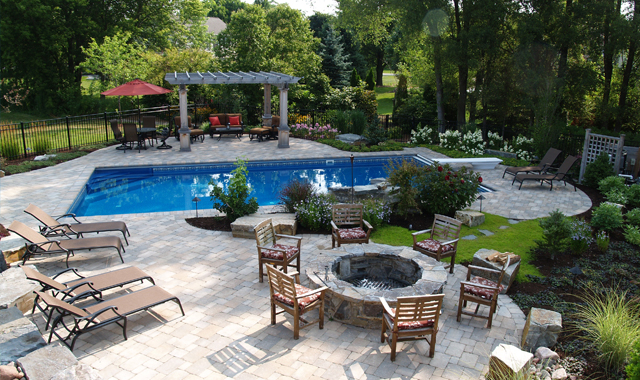Imagine having your own built-in vacation spot, a relaxing pool deck where you and your family can escape this summer. Dream no more, with some advice from these local experts.

What does your ideal backyard look like? Does it have a bubbling hot tub? Lounging furniture? A fire pit?
For many, the perfect outdoor space starts with a pool, for one simple reason: a pool is like a built-in vacation spot in your backyard, says Dennis Marunde, president of Arvidson Pools and Spas, which has locations in Crystal Lake, St. Charles and Palatine.
“I started to really love what I’m doing and what our company represents when I started to hear people who own our pools saying to us, ‘It has totally transformed our lives,’” says Marunde. “‘We totally changed the way we entertain in the summertime. We spend more time at home. We have more time with our children. We have opportunities to talk with our kids. We know their friends better because they all want to be at our place,’” Marunde says.
Hot tubs create similar effects.
“Families have told us, ‘The best time of our day is when we’re in the hot tub with our teenagers – that’s the only time they talk to us,’” Marunde says. “These are wonderful, intangible benefits. Sometimes, all people need is a couple of hours of relief, and they get that with their pool and hot tub.”
Of course, you can’t spend all of your time in the water. That’s where patio furniture comes in handy.
“I’ve seen more and more people purchasing the type of furniture that they sit in and relax,” says Steve Olson, manager of Viking Ski and Patio Shop in Barrington. “More people are spending time around home, so they’re investing more in their backyards. The backyard is becoming an extension of the house, instead of a separate space.”
So, how do you know what pool and patio furniture is right for your home?
The experts can help you figure that out. In fact, they’re ready to dive into your project.
“What we’re trying to create is a situation where this pool could not exist without this house, and this house could not exist without this pool,” says Mike Murillo, manager of Barrington Pools. “It should scream to you, ‘I love it!’”
Understand the Basics
Before you delve into the fun details of your pool, you’ll need to focus on a few building basics.
First, find out what zoning requirements or limitations exist in your neighborhood. You may have to maintain a certain clearance from your lot line, or you may be limited in the type of pool you can install.
“Some homeowners associations don’t allow above-ground pools,” Marunde says. “So, it’s a good idea to know in advance whether or not you can sink the pool in the backyard.”
As you’re figuring out your regulations, keep in mind your pool contractor will need access to your backyard.
“If it’s a tight lot, we’ve had to figure out how to get to the build site,” Marunde says. “We can’t use a helicopter to drop in equipment every day. How do we get our excavating equipment into your yard? Sometimes, we ask neighbors to go through their backyard. Other times, only a hand-dug pool is possible, and that’s very expensive.”
Ground conditions also affect what type of pool you install.
If you live close to the Fox River or another body of water where the water table is very high, or if you live on a sandpit, your installation may be more expensive, says Marunde. In both situations, the foundation beneath the pool will need to be built up. Certain types of pools work better in certain types of soil, so knowing your ground conditions ahead of time will help to narrow your options.
Your timeline and budget will be your last major considerations.
A top-of-the-line, in-ground pool with all the upgrades easily can cost upwards of $300,000, Marunde says.
“Those are fully automated pools that clean themselves, take care of their own chemical balance, turn on and off with your smartphone, can alert you if someone opens your pool cover, have fountains and water features and more,” he says.
Prepare for a reasonable project timeline, Marunde adds. That bells-and-whistles pool can take up to six months to build, whereas a more modest $50,000 in-ground pool can take just three weeks. An above-ground pool can be installed in one day.
You don’t need to have all of the answers before you hire a pool builder. In fact, most builders will walk you through these steps, and help you secure the proper permits you’ll need to proceed. If you enter a project understanding that zoning, site conditions, accessibility, timelines and budget need to be assessed before the project begins, you can more easily avoid becoming overwhelmed, and possibly disappointed, by the process.
Size and Style Matter
After preliminary building details have been discussed, you can think about the style and depth of pool you want.
Do you need the depth to dive, cannonball and jackknife into the water? Or would a shallower pool fit better with your plan to relax on a floating lounge with a drink in your hand?
Similarly, do you want a narrow sport pool to swim laps? Or, would a freeform pool with plenty of space for partygoers fit your style better?
There are also vanishing-edge pools, natural pools and other styles to consider.
For some builders, geometric shapes – round, oval, square and rectangular pools – are less complicated, and therefore less expensive, than freeform or other specialty pools, although that’s not always the case.
Ask yourself if you want your outside space to reflect your inside space, or if you want something completely different. And share that information with your builder.
“I can meet you at your home, and I can start seeing your tastes, your flairs, immediately,” says Murillo, of Barrington Pools. “Perhaps your home is ultra-modern, with clean lines – everything is straight – and I can see that. But then you want this natural, freeform pool. It doesn’t go with your decorating, your decor, your house – I just have to say something. If you say you want it, then fine. We’re good. But regardless of whether you want a freeform, modern, or classic design, I can still pick out an element, either outside or inside, and incorporate it in the design to connect the spaces.”
Make a Statement
If you’re looking to really add luxury to your pool area, there are several ways to make your backyard oasis shine.
Fire and water features, from cascading waterfalls to huge fire pits chiseled out of outcropping stones, can enhance any backyard pool.
“It screams that it’s custom and high-end – and it is,” Murillo says. “Whenever you put fire and water together, it just looks beautiful.”
Automated fire bowls allow homeowners to switch the flame on or off with the push of a button.
But the automation doesn’t end there. Hot tubs can be programmed to turn on and warm up to 104 degrees in less than 10 minutes, with the lighting set to just the right ambiance. By the time you get home from work, you can slip into the warmth and feel the relaxing power of hydrotherapy jets, Murillo says.
If you’ve already started your project, but want to add something like a hot tub, it’s not too late.
“It’s a small add-on at that point, because we’re already out there building the pool,” Murillo says. “It’s going to cost you a fraction of the regular cost. Most of our pools have spas for that reason.”
As you’re going through your pool design, you’ll also be asked what materials you’d like to use. Understand that materials can make or break your pool, literally and figuratively.
Popular high-end materials include porcelain imported from Italy and Pebble Technology pool finishes, which are gorgeous, algae-proof interior finishes that come with a 10-year warranty.
Such top-of-the-line materials are like installing hardwood floors in your house, Murillo says. Not only will you notice the difference cosmetically, but you won’t run into common pool problems like cracks, leaks or fading materials.
If the budget isn’t a concern, let your imagination run wild, Murillo says.
One of his projects included a 60-foot-long outdoor kitchen with a pizza oven overlooking a massive, intricately detailed pool and a changing room.
Another build required a crane to set the pieces of a 22-foot-high water feature, built entirely of natural stone.
Regardless of your budget, don’t be afraid to dream big.
“Most of the time, people end up wishing they had spent more or bought more than they did,” Marunde says. “If there is a regret, it’s that they didn’t do more.”
Deck Out Your Patio
Once you have your dream pool and all its accoutrements all set and ready to go, you’ll probably want to furnish your patio space Just as your pool requires forethought, so does your furniture.
The first question you should ask yourself is whether you need deep seating or dining furniture.
More customers are choosing deep seating options, which include sofas and other lounge seating meant for relaxing in your outdoor space, says Olson.
Some customers are dropping the traditional sofa in favor of multiple pairs of chairs – up to four or six in a single area.
“Individual chairs are a little bit easier to sit on, instead of piling two people onto a loveseat,” Olson says. “You don’t see three people sitting on a sofa on a couch too often, even in a house – you usually see only two people.”
If you plan to host outdoor meals and parties, you may want to add dining arrangements.
Whatever your choice, make sure to calculate the dimensions of your patio.
You don’t have to measure to the exact inch, but if you can come in with a measurement of the space, it will be easier to design the patio, Olson says.
As always, your budget largely will determine what options you can consider. Viking offers a variety of price points.
A dining set for four people could start at $799, but there are also $6,000 options.
Deep seating sets – including a sofa, two chairs and a coffee table – start at $2,499, while the average top-end sets are about $9,000.
The difference in price is based on material, Olson says. Vinyl wicker comes in two grades: virgin vinyl, which is typically a higher grade, and recycled vinyl. Both are durable, all-weather materials.
Metal frame furniture, meanwhile, comes in aluminum or iron options. Iron frames are strong, but can rust over time. Aluminum frames are more expensive, but never rust.
When it comes to color palettes, gray frames and cushions have been a popular option in recent years, Olson says. No matter your choice of frame, the included all-weather cushions come in hundreds of colors.
But not everyone wants cushions. In that case, chairs made of recycled plastic may be a better option.
Viking carries Berlin Gardens, a brand that builds its furniture with “poly lumber,” material made from 96-percent recycled content. The furniture is extremely durable and although it looks like wood, it’s made primarily of recycled milk bottles.
“It’s actually not super-cheap because it’s fairly heavy,” Olson says. “The quality is good as far as construction. It’s cheaper than good wood, like cedar, and not as expensive as teak wood, but you don’t have to worry about rot. This is for those who want no maintenance.”



















































